
Background information
The history of "Donkey Kong": Highs and lows of Nintendo's favourite gorilla over the last 44 years
by Cassie Mammone

From controversial shooter to the brand revival by Swedish developer Machine Games: To celebrate the 30th anniversary of «Wolfenstein 3D», we’re looking back at the legendary «Wolfenstein» series.
This article was originally published by our content partner «PC Games». Check out the original article by OIaf Bleich, Benedikt Plass-Fliessenkämpfer and Lukas Schmid.
What many don’t know: the «Wolfenstein» series didn’t start with «Wolfenstein 3D»! After all, the «3D» in the title doesn’t just describe the game’s modern presentation, but ultimately also denotes a third instalment in the series. It originated at Muse Software in the early 1980s. The US company, founded in 1978 by Ed Zaron and Silas S. Warner, developed video games and classic home user software such as the word processor Super-Text. Warner eventually came up with the idea for a game where «some guy would walk through rooms».
Doesn’t sound like much, and unsurprisingly, it didn’t turn into a game at first. It wasn’t until Warner saw the war flick The Guns of Navarone (1961) starring Gregory Peck and Anthony Quinn and tested the action game Berzerk on the same day that a concept developed. In «Castle Wolfenstein», the player took on the role of a U.S. soldier captured by Nazis, shooting their way out of the eponymous complex using heavy ordinance. Boiled down, the game featured action as well as very early stealth elements, and is therefore considered a great pioneer for the genre.
Warner also developed a random number generator that reshuffled the 60 or so rooms at the start of a game. Strikingly, voice lines were used even then, which Warner recorded in Muse’s «The Voice» software. And that’s how we got exclamations such as «Achtung, Schweinehund. Halt!» in game. «Castle Wolfenstein» was released in September 1981 on the Apple II, but was also implemented for Commodore 64 and Atari 400/800, among others. The game had sold about 50,000 copies by 1983.
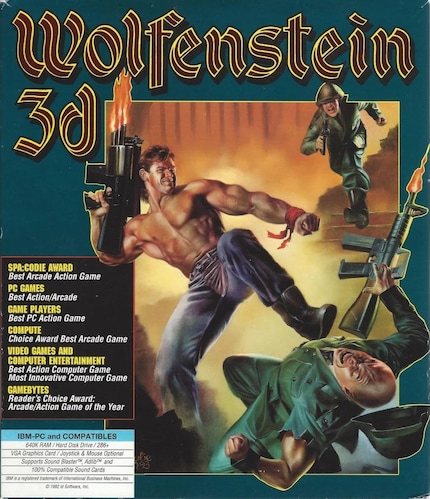
The sequel, published in 1985, continued the story. This time, Adolf Hitler was to be blown up using a previously captured bomb in a Berlin bunker. The developers pushed stealth elements, replacing grenades with silent daggers, for example. It was also possible to hide killed enemies.
However, the game didn’t deliver. It had stagnated too much in terms of content. In any case, Muse Software was already in dire financial straits at this time and laid off large parts of its workforce. While Warner moved to Microprose, Muse Software finally broke up in 1987.
The «Castle Wolfenstein» brand disappeared from the market in the wake of Muse’s bankruptcy. But one young development team of former Softdisk employees hadn’t forgotten about it: id Software. Founded on February 1, 1991, the U.S. studio consisting of John and Adrian Carmack, John Romero and Tim Hall enjoyed early success with the Commander Keen series, and was looking for a new challenge.
The idea of a new spin on «Castle Wolfenstein» came up. But who owned the licence was unclear following Muse Software’s demise. So they called Silas Warner, who found out. In the end, id Software bought the «Wolfenstein» licence for $5,000. From today’s point of view, an almost insane bargain!
Work on «Wolfenstein 3D» began in mid-January 1992. It was based on Catacomb 3D technology, which appeared in November 1991, but at that time was still using 16 colours and EGA resolution. Adrian Carmack took the creative visual lead as head artist, working out 2D sprite graphics in 16 colours.
However, due to the 3D environment, it quickly became clear that a simple sprite wouldn’t suffice. Eventually, animations would have to be included that could show the characters in motion from all sides. id Software needed help. So they brought Jim Norwood on board. He had previously worked at Apogee as a software developer, also handling art design. He suggested switching from EGA to VGA, thus also from 16 to 256 colours. This offered more possibilities when creating character models and levels. Especially when it came to the design of environmental graphics, id Software had more options open as a result.
But that wasn’t the only technical innovation. The then advanced Sound Blaster technology was used to integrate voice samples – matching the original. Naturally, the soundscape also included the, for that time, crazy weapon effects. In the level construction kit TED5, it was also possible to create so-called «Sound Zones». This made it possible to cordon off individual areas on the maps. In practice, this meant that if you shot around in room A, you wouldn’t alert all the guards in room B. This prevented enemies from leaving their positions all at once in the worst case, leading to an empty level.
Initially, the gameplay in «Wolfenstein 3D» was still strongly oriented around its two predecessors. During the 2022 Game Developers Conference, John Romero explained that features such as «searching bodies, pulling soldiers away so others wouldn’t see them and get suspicious, or even breaking into stores or closets» were still included at first.
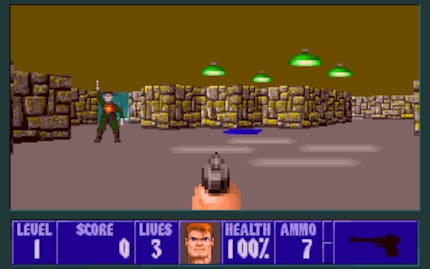
However, it quickly became apparent that the «Run’n’Gun» gameplay was much more enjoyable to the team. «Throughout the development of a game, you try to bring out the fun. And sometimes this brings along features you didn’t initially expect. You have to listen to the game. Fun in «Wolfenstein» came from the fast running and the incredibly brutal actual. The rattling of your Gatling gun, the sounds of pain and death – they were the heartbeat of the game,» Romero martially elaborates. All superfluous elements that could slow down gameplay were removed piece by piece. U.S. Army Ranger William Joseph Blazkowicz («BJ» for short) debuted as the title character, tasked with assassinating Adolf Hitler. His target eventually confronts him as a cyborg by the end of the game. Although later instalments in the series introduce an alternate «Wolfenstein» timeline, with the exception of «Wolfenstein: Enemy Territory» (2003), Blazkowicz was always the main character.
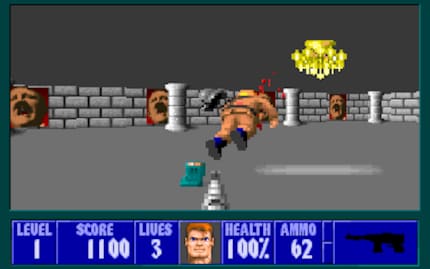
The development history of «Wolfenstein 3D» is full of exciting anecdotes. For example, a collaboration between Sierra Online and id Software almost happened, but it failed due to financial disagreements.
In addition, id Software also moved from cold Wisconsin to sunny Dallas, Texas during the development of «Wolfenstein». The core team, which later consisted of eight men, cultivated an exceptionally close working relationship during this time and was aware that something special was about to be created.
However, unlike today’s productions, «Wolfenstein 3D» didn’t appear as one big full version. Instead, they relied on the shareware model popular at the time. To those of you who don’t know: a shareware version went out first and was free to copy; it served as an appetiser.
«The idea was that we would release the shareware and start selling it. In that time frame, we would eventually finish the remaining two chapters. We still had to finish the 20 levels so we could send them out to customers,» explains John Romero.
Apogee founder Scott Miller developed a comprehensive sales model with multiple pricing tiers: for $35 players received 30 levels in three parts, for an extra $15 they got a trilogy of 30 additional stages, and for another ten dollars they were sent a manual with detailed information about the entire game.
For the team, this meant tough weeks of crunching, including developing installation and packing routines. After all, back then games were still distributed on floppy disks and couldn’t be conveniently downloaded from the Internet. Finally, after one last night shift, «Wolfenstein 3D» was finished on May 5, 1992 – fittingly, this was also Adrian Carmack’s 33rd birthday. Romero summed up that moment in a single sentence: «We left the office very tired, but we knew that everything had changed.»
«Wolfenstein 3D» was thus released as a shareware game, quickly reaching a large audience. The majority of customers were so enthusiastic about the shooter that they bought the complete package with all levels and the manual. By the end of 1993, over 100,000 versions of the game had gone out, according to Apogee.
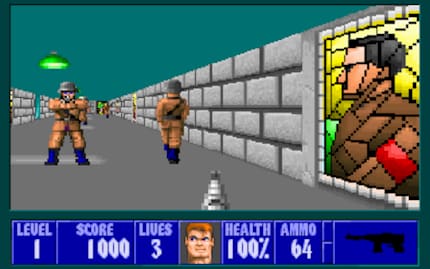
By 1995, as many as 250,000 copies had sold, adding up to two and a half million dollars. 20 per cent of sales were generated in non-US markets. In Germany, the game was often sold under the table or even passed on as an illegal pirated copy. «Wolfenstein 3D» and the expansion Spear of Destiny, also refused a release in Germany, gave id Software an enormous financial boost, as well as technical know-how for their next big shooter: Doom.
In Germany, however, «Wolfenstein 3D» was quickly caught in the crossfire of youth protection. On January 25, 1994, the game was seized by the Munich and Tiergarten District Courts. However, the reason for this wasn’t the use of anti-constitutional symbols such as swastikas.
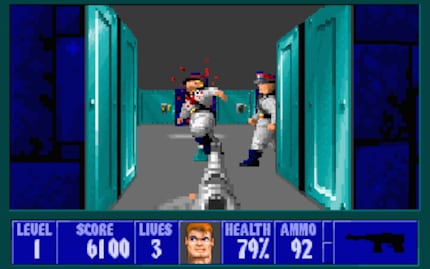
Rather, the verdict was based on the excessive depiction of violence and the «in-game glorification of vigilante justice as well as the positive portrayal of grotesque deaths».
Due to its Nazi symbolism, «Wolfenstein 3D» got into the press again four years later. A «member of the National Socialist scene» used the shooter and its staging of swastikas, Hitler images and the Horst Wessel song in the main menu as an object for Nazi propaganda and distributed it via his forum.
The right-wing extremist was convicted by the Higher Regional Court of Frankfurt am Main, but the scope of this verdict hit the games industry especially hard. The judges didn’t apply the Social Adequacy Clause, which allowed art to display such symbols and motifs.
This ruling strongly influenced developers and distributors, ultimately ensuring that games with swastikas and other motifs had to be adapted in Germany for decades. The confiscation of «Wolfenstein 3D» and its removal from the index didn’t take place in Germany until the autumn of 2019.
As Doom became even more successful than «Wolfenstein 3D», id Software set other priorities. They gave out the licence to external developers and just oversaw production: released in 2001, «Return to Castle Wolfenstein» was developed by Gray Matter Interactive as well as Nerve Software and is still on the index in Germany.
However, a planned expansion of the solo campaign wouldn’t come to be. A single player mode for «Wolfenstein: Enemy Territory» was discontinued in 2003 due to development problems. However, id Software as well as co-developer Splash Damage and publisher Activision didn’t drop the project. Instead, they released the finished multiplayer mode for free to download. The tactical shooter was considered an alternative to Counter-Strike for many years and enjoyed great popularity in the e-sports and online scenes. Released in 2009 and developed by Raven Software, «Wolfenstein» was indexed in its original version and seized nationwide. A German version, on the other hand, was simply withdrawn.
«Wolfenstein» was in crisis at that time, and far from the glory of earlier days. At the same time, Zenimax Media, Bethesda’s parent company, acquired id Software, and with it the «Wolfenstein» brand. While id was working on a new direction for Doom, the Swedish studio Machine Games was entrusted with a series reboot. Jens Matthies, studio co-founder and creative director of «Wolfenstein: The New Order,» explained their approach to PC Gamer: «We took a look at «Wolfenstein 3D». It’s the main source and freest interpretation of «Wolfenstein». After all, it was developed by a few young guys in their basement – without any pretence for true art. It’s just the stuff they thought was cool, and that’s the power behind that mindset.»
They took a strong cue from the original, making BJ Blazkowicz a taciturn and war-weary soldier who falls into a coma after escaping from Castle Wolfenstein and suddenly finds himself in a world ruled by Nazis. «When you develop a Wolfenstein game, you’re going to deal with Nazis. That’s a fact you can’t get past. The question, however, is how to approach a struggle against Nazis in the most impressive and forceful way. Even though we overstylize the Nazis in-game, they’re still based on a real ideology. If we had treated this aspect less clearly, it would’ve been a trivialisation of what this ideology is all about,» he continues.
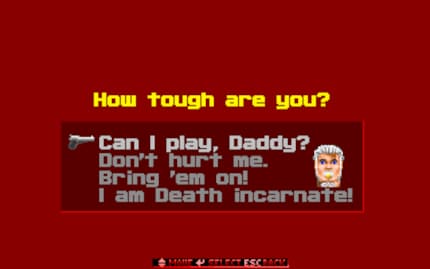
«That’s a fact you can’t get past. The question, however, is how to approach a struggle against Nazis in the most impressive and forceful way. Even though we overstylize the Nazis in-game, they’re still based on a real ideology. If we had treated this aspect less clearly, it would’ve been a trivialisation of what this ideology is all about,» he continues.
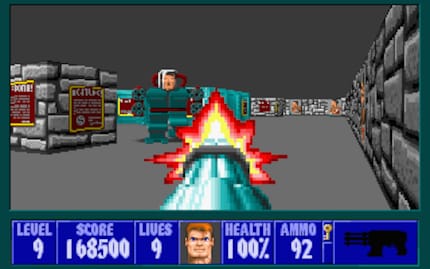
«You’re on a battlefield fighting Nazis… but sometimes you just have to carry a tray of coffee and serve it. I love it. I think that anchors the action in reality.» Nevertheless, the game appeared in Germany in an adapted form: here, BJ Blazkowicz fought against the «Regime», and the symbolism was also changed.
«Wolfenstein: The New Order (2014)» and «Wolfenstein 2: The New Colossus» were two of the best story shooters around at the time, convincing with their powerful technology, impressive gameplay and strong narrative underlining everything.
Released in 2016, «Wolfenstein: The Old Blood,» a co-op spin-off «Wolfenstein: Youngblood» (2019) and the VR adaptation «Wolfenstein: Cyberpilot» (2019) couldn’t quite keep up in terms of quality. The last two titles, however, were the first instalments in the series to fall under the social adequacy clause, again depicting swastikas and other motifs in Germany.
«Wolfenstein 3D» looks back on a thirty-year history that can still be found in current releases. What would the gaming world have looked like if «Wolfenstein 3D» hadn’t been a success? Even if many people today consider Doom to be the initial spark for the shooter revolution, «Wolfenstein 3D» certainly plays an equally important role.
PC games: cutting-edge news, videos, previews and critical reviews, thoroughly researched reports and handy tips on everything to do with PC games, console games and PC hardware.
Interesting facts about products, behind-the-scenes looks at manufacturers and deep-dives on interesting people.
Show all
Background information
by Cassie Mammone

Background information
by Kevin Hofer

Background information
by Philipp Rüegg